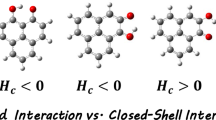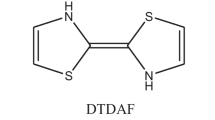Abstract
The point-of-charge (PoC) approach was employed to investigate the characteristics of the tetrel bond from an electrostatic perspective. W–T–XYZ···B nomenclature was suggested where T is a tetrel atom, W is the atom along the σ-hole extension, B is a Lewis base, and X, Y, and Z are three atoms on the same side of the σ-hole. Quantum-mechanical calculations were carried out on F–T–F3 systems (where T = C, Si, Ge, or Sn) at the MP2/aug-cc-pVTZ level of theory, with PP functions for Ge and Sn atoms. The tetrel bond strength was estimated via the molecular stabilization energy. Tetrel bond strength was found to increase with increasing PoC negativity (i.e., Lewis basicity) and the electronegativity of the W atom. Moreover, the effects of the T···PoC distance, the W–T···PoC angle, and the aqueous medium on the tetrel bond strength were also investigated. Correlations between tetrel bond strength and several atomic and molecular descriptors such as the natural charge on the tetrel atom, EHOMO, and the p-orbital contribution to W–T bond hybridization were observed. Contrary to expectations, the tetrel bond strength in F–C–X3 increased as the electronegativity of X decreased. The σ-node criteria for the studied molecules were also introduced and discussed. The ability of these molecules to simultaneously form more than one tetrel bond was examined via the σn-hole test. In conclusion, the tetrel bond strength was found to be governed by the strengths of (i) the attractive electrostatic interaction of the Lewis base with the σ-hole, (ii) the attractive/repulsive interaction between the Lewis base and the X, Y, and Z atoms, and (iii) the van der Waals interaction between the Lewis base and the X, Y, and Z atoms.

Characterization of tetrel bond using the Point-of-Charge (PoC) approach.











Similar content being viewed by others
References
Clark T, Hennemann M, Murray JS, Politzer P (2007) Halogen bonding: the σ-hole. J Mol Model 13(2):291–296
Brammer L (2004) Developments in inorganic crystal engineering. Chem Soc Rev 33(8):476–489
Politzer P, Murray JS, Concha MC (2007) Halogen bonding and the design of new materials: organic bromides, chlorides and perhaps even fluorides as donors. J Mol Model 13(6):643–650
Hernandes MZ, Cavalcanti SMT, Moreira DRM, de Azevedo Junior WF, Leite ACL (2010) Halogen atoms in the modern medicinal chemistry: hints for the drug design. Curr Drug Targets 11(3):303–314
Wilcken R, Zimmermann MO, Lange A, Zahn S, Boeckler FM (2012) Using halogen bonds to address the protein backbone: a systematic evaluation. J Comput Aided Mol Des 26(8):935–945
Ibrahim MAA (2011) Molecular mechanical study of halogen bonding in drug discovery. J Comput Chem 32(12):2564–2574
Murray J, Lane P, Politzer P (2009) Expansion of the σ-hole concept. J Mol Model 15(6):723–729
Bauzá A, Mooibroek TJ, Frontera A (2013) Tetrel-bonding interaction: rediscovered supramolecular force? Angew Chem Int Ed 52(47):12317–12321
Grabowski SJ (2014) Tetrel bond–σ-hole bond as a preliminary stage of the SN2 reaction. PCCP 16(5):1824–1834
Scheiner S (2013) Detailed comparison of the pnicogen bond with chalcogen, halogen, and hydrogen bonds. Int J Quantum Chem 113(11):1609–1620
Li Q-Z, Li R, Liu X-F, Li W-Z, Cheng J-B (2012) Concerted interaction between pnicogen and halogen bonds in XCl–FH2P–NH3 (X = F, OH, CN, NC, and FCC). ChemPhysChem 13(5):1205–1212
Gleiter R, Werz DB, Rausch BJ (2003) A world beyond hydrogen bonds? Chalcogen–chalcogen interactions yielding tubular structures. Chem Eur J 9(12):2676–2683
Esrafili MD, Mohammadian-Sabet F (2015) Does single-electron chalcogen bond exist? Some theoretical insights. J Mol Model 21(3):65–73
Legon AC (2010) The halogen bond: an interim perspective. PCCP 12(28):7736–7747
Wang Y-H, Zou J-W, Lu Y-X, Yu Q-S, Xu H-Y (2007) Single-electron halogen bond: ab initio study. Int J Quantum Chem 107(2):501–506
Quinonero D (2017) Sigma-hole carbon-bonding interactions in carbon–carbon double bonds: an unnoticed contact. PCCP 19(23):15530–15540
Politzer P, Murray JS, Lane P, Concha MC (2009) Electrostatically driven complexes of SiF4 with amines. Int J Quantum Chem 109(15):3773–3780
Davis MF, Levason W, Reid G, Webster M, Zhang W (2008) The first examples of germanium tetrafluoride and tin tetrafluoride complexes with soft thioether coordination—synthesis, properties and crystal structures. Dalton Trans 4:533–538
Li Q, Guo X, Yang X, Li W, Cheng J, Li H-B (2014) A σ-hole interaction with radical species as electron donors: does single-electron tetrel bonding exist? PCCP 16(23):11617–11625
Laconsay CJ, Galbraith JM (2017) A valence bond theory treatment of tetrel bonding interactions. Comput Theor Chem 1116:202–206
Liu M, Li Q, Li W, Cheng J, McDowell SAC (2016) Comparison of hydrogen, halogen, and tetrel bonds in the complexes of HArF with YH3X (X = halogen, Y = C and Si). RSC Adv 6(23):19136–19143
Murray JS, Concha MC, Politzer P (2011) Molecular surface electrostatic potentials as guides to Si–O–N angle contraction: tunable σ-holes. J Mol Model 17(9):2151–2157
Grabowski SJ (2017) Lewis acid properties of tetrel tetrafluorides—the coincidence of the σ-hole concept with the QTAIM approach. Crystals 7(2):43–56
Scheiner S (2017) Systematic elucidation of factors that influence the strength of tetrel bonds. J Phys Chem A 121(29):5561–5568
Ibrahim MAA, Hasb AAM, Mekhemer GAH (2018) Role and nature of halogen bonding in inhibitor···receptor complexes for drug discovery: casein kinase-2 (CK2) inhibition as a case study. Theor Chem Accounts 137(3):38–47
Møller C, Plesset MS (1934) Note on an approximation treatment for many-electron systems. Phys Rev 46(7):618–622
Woon DE, Dunning TH (1994) Gaussian basis sets for use in correlated molecular calculations. IV. Calculation of static electrical response properties. J Chem Phys 100(4):2975–2988
Woon DE, Dunning TH (1993) Gaussian basis sets for use in correlated molecular calculations. III. The atoms aluminum through argon. J Chem Phys 98(2):1358–1371
Feller D (1996) The role of databases in support of computational chemistry calculations. J Comput Chem 17(13):1571–1586
Lu T, Chen F (2012) Multiwfn: a multifunctional wavefunction analyzer. J Comput Chem 33(5):580–592
Glendening ED, Landis CR, Weinhold F (2013) NBO 6.0: natural bond orbital analysis program. J Comput Chem 34(16):1429–1437
Reed AEL, Curtiss LA, Weinhold F (1988) Intermolecular interactions from a natural bond orbital, donor-acceptor viewpoint. Chem Rev 88(6):899–926
Boys SF, Bernardi F (1970) The calculation of small molecular interactions by the differences of separate total energies. Some procedures with reduced errors. Mol Phys 19(4):553–566
Frisch MJ, Trucks GW, Schlegel HB, Scuseria GE, Robb MA, Cheeseman JR, Scalmani G, Barone V, Mennucci B, Petersson GA, Nakatsuji H, Caricato M, Li X, Hratchian HP, Izmaylov AF, Bloino J, Zheng G, Sonnenberg JL, Hada M, Ehara M, Toyota K, Fukuda R, Hasegawa J, Ishida M, Nakajima T, Honda Y, Kitao O, Nakai H, Vreven TJA, Montgomery J, Peralta JE, Ogliaro F, Bearpark M, Heyd JJ, Brothers E, Kudin KN, Staroverov VN, Kobayashi R, Normand J, Raghavachari K, Rendell A, Burant JC, Iyengar SS, Tomasi J, Cossi M, Rega N, Millam JM, Klene M, Knox JE, Cross JB, Bakken V, Adamo C, Jaramillo J, Gomperts R, Stratmann RE, Yazyev O, Austin AJ, Cammi R, Pomelli C, Ochterski JW, Martin RL, Morokuma K, Zakrzewski VG, Voth GA, Salvador P, Dannenberg JJ, Dapprich S, Daniels AD, Farkas O, Foresman JB, Ortiz JV, Cioslowski J, Fox DJ (2009) Gaussian 09, revision E01. Gaussian, Inc., Wallingford
Bundhun A, Ramasami P, Murray JS, Politzer P (2013) Trends in σ-hole strengths and interactions of F3MX molecules (M = C, Si, Ge and X = F, Cl, Br, I). J Mol Model 19(7):2739–2746
Acknowledgements
This work was supported by the Science and Technology Development Fund, STDF, Egypt, under grant no. 5480.
Author information
Authors and Affiliations
Corresponding author
Rights and permissions
About this article
Cite this article
Ibrahim, M.A.A., Moussa, N.A.M. & Safy, M.E.A. Quantum-mechanical investigation of tetrel bond characteristics based on the point-of-charge (PoC) approach. J Mol Model 24, 219 (2018). https://doi.org/10.1007/s00894-018-3752-2
Received:
Accepted:
Published:
DOI: https://doi.org/10.1007/s00894-018-3752-2




